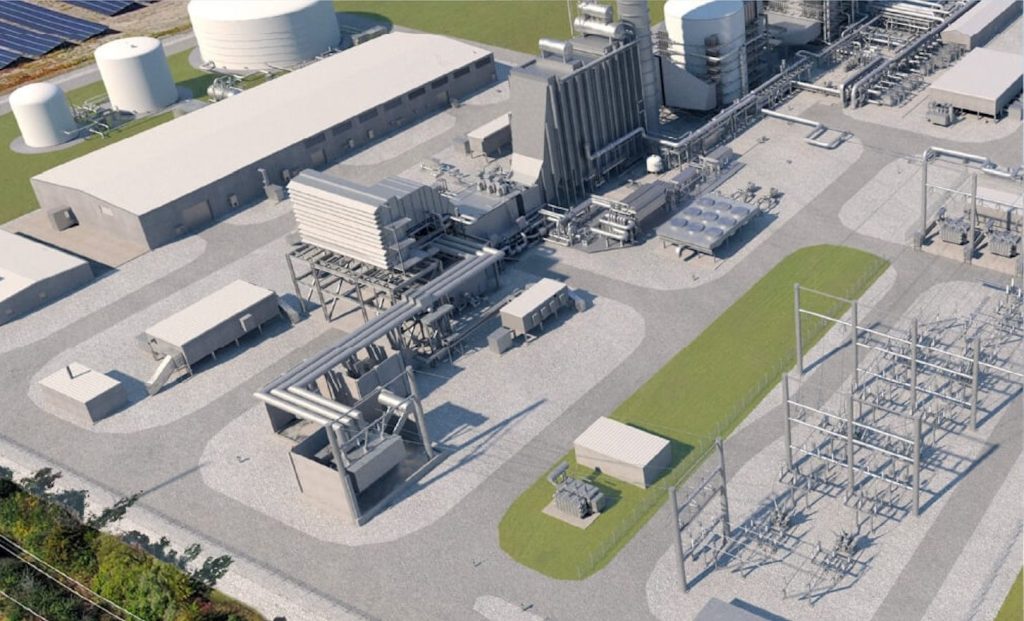Google is funding a new natural gas plant outfitted with carbon capture and storage
The first-of-a-kind contract will support the construction of up to 400 megawatts of around-the-clock generation capacity. Read More

- The power plant will be near an Archer Daniels Midland ethanol production site.
- The captured carbon will be stored in an existing sequestration facility in use for almost a decade.
- Construction is scheduled to start in 2026, and the project is slated for commercial production in 2030.
Google’s thirst for more data center energy capacity around the clock led it to sign a first-of-a-kind contract that will fund a carbon capture and storage system at a new natural gas plant in Illinois.
Under the agreement, disclosed Oct. 23, Google will buy most of the electricity from the Broadwing Energy Center in Decatur, a combined heat and power facility with 400 megawatts of generation capacity being built near an ethanol plant run by Archer Daniels Midland. The electricity will be added to the regional grid that serves Google’s data centers in Illinois and Arkansas. The steam produced at the site — more than 1.5 million pounds per hour — will be used by ADM’s industrial processes.
Approximately 90 percent of the emissions generated by the new natural gas plant will be captured and stored in an existing sequestration site one mile underground, which ADM has used since 2011 to house more than 4 million tons of carbon dioxide. The facility can store 2 million metric tons of CO2 annually.
“Our goal is to help bring promising new [carbon capture and storage] solutions to the market while learning and innovating quickly — the same approach we’ve taken with other advanced energy technologies,” said Michael Terrell, head of advanced energy at Google, in a blog disclosing the project.
“This project in Illinois would be one of the first gas power plants of this size to use carbon capture in the country, demonstrating clearly that we have the technology to prevent CO2 emissions and that unabated gas should no longer be a choice,” said John Thompson, technology and markets director at energy NGO Clean Air Task Force, in a statement.
Multi-pronged approach
Google’s clean electricity strategy, published in September 2023, outlines a plan to use a wide range of renewable generation sources including geothermal, hydro, nuclear, solar and wind to reduce related emissions. The tech company uses power purchase agreements and special tariff agreements to offset the cost of using newer technologies.
The plan also names natural gas equipped with carbon capture and storage equipment as an important source of low-carbon power.
Google negotiated a special offtake agreement to fund the new Illinois plant; construction is slated to begin in 2026, with commercial operations slated for 2030. The project is the part of a long-term relationship between Google and developer Low Carbon Infrastructure, backed by investor Squared Capital.
“This partnership underscores how private investment, technology innovation and corporate energy demand can come together to deliver scalable climate solutions,” said Gautam Bhandari, Squared’s chief investment officer and managing partner.
U.S. demand for natural gas has spiked to its highest level in two decades, largely driven by big data center expansion projects, including artificial intelligence facilities planned by Amazon, Google, Meta and Microsoft. As large corporations invest more deeply in AI and other digital infrastructure, that ripple effect is pressuring corporate climate goals.
Carbon capture and storage is a viable solution for reducing emissions from plants that are at least 100 megawatts in capacity, according to an analysis by advisory firm Carbon Direct.
The Google deal offers an important proof point for the viability of these projects, which will be increasingly important over the next 18 months, said A.J. Simon, director of industrial decarbonization at Carbon Direct.
The project uses “low-risk” gas turbines from a respected equipment vendor, Mitsubishi, and a proven carbon capture and storage process from ADM, which helps with the economics. Google will use a new type of environmental attribute certificate to track and report on the emissions associated with the project. The certificates, designed by consulting firm Northbridge Energy, can be used in much the same way that corporations currently use renewable electricity certificates as part of greenhouse gas accounting inventories.
“Every single one of the pieces in this project reinforces that other,” Simon said.

Subscribe to Trellis Briefing
Featured Reports

The Premier Event for Sustainable Business Leaders
















